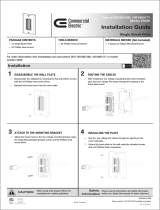
7 TEST PROCEDURES 30
7.1 Testing the motor 30
7.2 Testing the electro-mechanical parking brake 31
8 REPAIR WORK 33
8.1 Covers 33
8.1.1 Open front cover 33
8.1.2 Opening the rear cover 34
8.1.3 Opening the lateral cover 35
8.1.4 Opening the cover of the rear wheel cantilever arm 38
8.2 Electronic modules 39
8.2.1 Replacing remotes 39
8.2.2 Replacing electronic modules 39
8.2.3 Replacing the G-Trac module 42
8.2.4 Drive program selection after component replacement 44
8.2.4.1 Profile selection with G90A remote 44
8.2.4.2 Profile selection with remote REM A or REM B 45
8.2.4.3 Profile selection with remote REM 550 46
8.3 Updating the driving program 47
8.4 Batteries, cables & battery chargers 48
8.4.1 Removing the batteries 48
8.4.2 Replacing batteries / replacing battery cables 51
8.4.3 How to handle damaged batteries correctly 53
8.4.4 Replacing the main fuse 54
8.4.5 Checking the cables 55
8.5 Lighting system 57
8.5.1 Replacing light bulbs in the front (conventional lighting system) 57
8.5.2 Replacing the LEDs in the front (LED lighting system) 57
8.5.3 Replacing the complete head lamp assembly (conventional lighting system) 58
8.5.4 Replacing the head lamps completely (LED lighting system) 60
8.5.5 Replacing the head lamp bracket (conventional lighting system) 62
8.5.6 Replacing a light bulb in the rear (conventional lighting system) 63
8.5.7 Replacing the LEDs in the rear (LED lighting system) 63
8.5.8 Replacing the complete tail lamp assembly (conventional lighting system) 64
8.5.9 Replacing the tail lamp bracket (conventional lighting system) 66
8.5.10 Replacing the tail lamps completely (LED lighting system) 67
8.6 Seat / seat frame (without lifter) 68
8.7 Replacing the tilt module / lifter module 71
8.7.1 Replacing the tilt module (without lifter) 71
8.7.2 Replacing the lifter / tilt module 74
8.7.3 Replacing the tilt actuator 78
8.7.4 Replacing the lifter actuator 80
8.7.4.1 Method 1 - uninstalling the lifter actuator with the lifter raised 80
8.7.4.2 Method 2 - uninstalling the lifter actuator with the lifter lowered 82
6





















